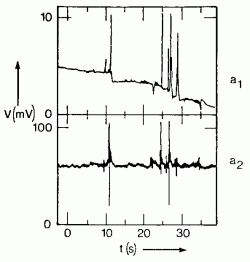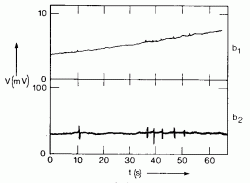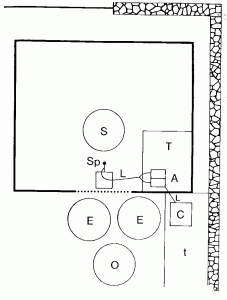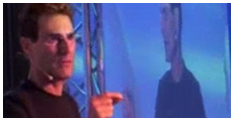PARANORMAL METALBENDING, RESEARCHES WITH PIEZOELECTRIC SENSORS
Presented at The Society for Psychical Research Centenary Conference/Parapsychological Association Jubilee Convention, held at Trinity College, Cambridge, 16 – 21 August 1982.
Department of Physics Birkbeck College (University of London) Malet Street London WC1E 7HX
Introduction
It has been our experience(1-6) that by far the most suitable experimental methods of investigating paranormal metalbending are those in which the detection of psychokinetic effects at a metal target is achieved without the target being touched by the subject to whom it is exposed. Clearly such an exposure requires careful observation of the subject during the entire experimental session. No-touch protocol is also required in psychokinetic experiments with random event generators, but in paranormal metalbending a simple physical target, as opposed to a ‘black box’ piece of electronic circuitry, is exposed to the perception of both subject and experimenter.
The simplest physical quantity whose paranormal variation can be observed is strain, or physical deformation of the otherwise stable metal target. This can be either temporary (dynamic, or elastic) or permanent (beyond a yield point). Visual observation of strain is insensitive, even more in the case of elongation than in that of bending. However, various transducers are available by means of which even micro-strains, proportional changes of dimension delta l / l ~= 10^-6, can be detected as electrical signals, or voltages. The simplest of these is the resistive strain gauge, with which much paranormal metalbending information has been obtained.
Another transducer suitable for such observations is piezoelectric material, particularly piezoelectric ceramics such as lead zirconate titanate (PZT), which are used as gramophone pick-ups and in other applications. These have very much greater sensitivity than the resistive strain gauge, strains as small as delta l / l ~= 10^-10 being readily detectable. The background noise from a resistive strain gauge, with its attendant bridge, amplifier and chart recorder, is electrical in origin, whilst the acoustic noise is much smaller. But with a piezoelectric sensor, amplifier and chart recorder, the acoustic sensitivity is so high that the background noise can be dominated by acoustic rather than electrical contributions. On these grounds the piezoelectric sensor is superior to the resistive strain gauge for the detection of paranormal metalbending signals.
This paper describes the experiments we have carried out during the past year on the detection of paranormal metalbending signals in the presence of metalbending subjects Stephen North, Heloise Gr. and Willie G.
Properties of Piezoelectric Sensors
In a piece of piezoelectric material the inherent electric charges are separated when mechanical stress is applied to produce a strain. The material is a good insulator, but has metal electrodes covering two opposing faces, and when the material is first prepared commercially, a high voltage is temporarily applied between these electrodes, so that the material becomes ‘poled’. On the subsequent application of stress parallel to these electrodes, a difference of electric charge is produced between the electrodes, this difference being proportional to the stress; the constant of proportionality is the appropriate ‘piezoelectric constant’ of the material.
In the simplest arrangement the polarization, P, which is essentially the difference of charge, is given by
P = dX + YE
where Y is the mechanical stress and d the piezoelectric constant; X is the dielectric susceptibility and E the electric field. He need not at this stage consider the tensor calculus which describes the array of such constants more rigorously.
The resistance of the piezoelectric material is almost infinitely high, so that the charge does not leak away, and can be taken to be approximately proportional to the stress. It might be measured on an electrometer amplifier, whose resistance is also almost infinitely high. Unlike the resistive strain gauge, the piezoelectric strain gauge is a very high impedance device.
Unfortunately this makes it almost useless for detection of paranormal metalbending signals without modification. Even with some electrical screening an electrometer amplifier input terminal is enormously sensitive to stray electric charge, arising from triboelectric effects, atmospheric ions, and even paranormal (otherwise inexplicable) electrical effects(5,6). Our experience both in thirty years of orthodox physics and seven years of research into psychokinesis suggests that exposed targets connected to high impedance electrometer amplifiers would not with certitude remain electrically stable.
We therefore virtually short-circuit the piezoelectric, whose capacitance is C, by connecting it across a low resistance (R = 3.5 kOhms). In this way the charge leaks away very rapidly, so that an amplifier and slow response chart recorder only records a very small fraction of it; most of the sensitivity is lost; however, there is ample to spare. The time constant for the leakage is RC, 3.5 kOhms x 500 pF = 1.75 microseconds. Owing to the slow response (O.1 s) chart recorder, we therefore lose a factor of about a hundred thousand in sensitivity. Moreover, since the voltage across R is recorded by the Amplifier, it is the current through R which determines the signal; the current is proportional to the first differential of the stress with respect to time, that is, to the rate of flow of charge. It follows that a rapid elastic dynamic strain, such as a sharp tap on the specimen with a pencil, is recorded not as a single ‘peak’, which would be the case for a resistive strain gauge, but as a peak in one direction immediately followed by a peak in the other direction. The contrast between up-and-down piezosensor signals and unidirectional strain gauge signals obtained paranormally on a single metal specimen is shown in the tracing of chart-records in Figure 1.
The hanging of a weight on the specimen for a period of time is recorded as an up-and-down signal occurring at the moment of hanging; there is no deflection while the weight is in place, and an up-and-down signal in the other direction at the moment when the weight is removed. This contrasts with the record obtained from a resistive strain gauge, which appears ideally as a square pulse whose duration is the period during which the weight is hung.
However, a single peak from a piezo-sensor on the chart recorder trace does not usually correspond to a permanent deformation, but rather to a sullen elastic deformation immediately damped, so that the specimen returns to its original form sufficiently slowly for the reverse signal to be too small for recording. _
With this arrangement of piezoelectric the sensitivity is not to be defined in terms of signal per unit stress, but rather in terms of signal per unit rate of variation of stress. Shocks produced by falling weights show sufficiently fast variation for them to be recorded rather more sensitively than they are with a resistive strain gauge. Falling weight calibration of our own system is as follows: 5 g falling through 10 mm onto the end of the piezoelectric produces an 8 mV chart recorded signal.
The signal across the 3.5 kOhm resistor is amplified by TD 1034A operational amplifier of gain 100, before chart recording. With this arrangement, the manufacturer’s static calibrations cannot be used, although it can be shown that our experiments are consistent with them. For their piezoelectric strain gauge BSG/1-1 (length 9.5 mm, width 1.6 mm, thickness 0.3 mm) Messrs. Vernitron give a figure of 2.2 x 10^5 V / strain and capacitance 500 pF. For the ceramic PZT5A the appropriate piezoelectric constant is given as 2 x 10^-2 V/m for unit stress 1 N/m^2.
The piezoelectric is mounted on or in the metal specimen, together with its electrical connections, using epoxy-resin. It is then further insulated with epoxy-resin, and electrically screened with layers of conducting paint, which connects to the metal itself and to the screening sheath of the electrical leads; variation of the capacitance of the latter produces signals, so that they must be carefully hung and not touched, and kept as short as possible. For comparison of piezoelectric with a resistive strain gauge, the latter is mounted on the back face of the metal, opposite the piezoelectric.
Another experimental method has been to expose to the subject a larger block of piezoelectric ceramic (50 mm x 7 mm x 7 mm) without attaching it to a metal specimen. Electrical screening is still important, and this is conveniently done with solid plastic coat covered with conducting paint.
Environment and Protocol of Sessions
Environment and protocol have been determined by the following aims of the experiments:
1. To test, and learn about the behaviour of, piezoelectric sensors exposed to metalbending subjects.
2. To learn about the psychological conditions under which metalbending action is most easily produced.
3. To make comparisons between piezoelectric sensors and resistive strain gauge sensors.
4. To test the accuracy with which a subject can forecast the production of a metalbending signal.
The environment of the experimental sessions with Stephen North and with Willie G. has been an isolated basement physics laboratory in Birkbeck College. Both subjects have previous experience of visiting the laboratory
for experimental sessions. The sessions with Heloise Gr. were carried out in the living room of the family house in a West Country town, since these were the first experiments in which the subject had participated. All sessions were held in the afternoon.
Within the basement physics laboratory an electrically screened room of dimensions 2.25 m x 1.6 m x 2.2 m high was constructed of 0.7 mm aluminium sheet. Care was taken to make good electrical contact between the individual metal sheets and especially to the metal sheet which formed the floor. A door 0.9 m, 2 m high was constructed of expanded aluminium with diamond-shaped apertures of axes 30 mm and 15 mm. Tests were made of the attenuation of commercial radio signals with door open and door closed. Since the screened room was in a basement laboratory and the door faced solid ground, the attenuation was only slightly affected by closing the door. This enabled us to conduct the exposure of the specimens to the subject while he was sealed inside the room and observed through the expanded aluminium door, either open or closed. A plan view of the arrangement of subject, specimens, apparatus and experimenters is shown in Figure 2.
The protocol of the experiment is as follows:
(i) The equipment is allowed to run in the absence of the subject for a period of about 30 minutes. An experimenter must be present for part of this time and must enter the Screened room and sit in the subject’s chair. No signals must be recorded during any of this period. Any drifting exhibited in the chart record is adjusted by the chart recorder zeroing control.
(ii) The equipment must contain a ‘dummy charnel'(3). This is an unscreened input resistance exposed within the screened room and connected to a separate amplifier channel ant chart recorder channel. All amplifiers are battery-operated, but it is possible, at least outside the screened room, for electrical mains pulses to reach the circuitry despite screening. Such a pulse would show up on both dummy and sensor channels, so that such an appearance cannot be mistaken for a paranormal pulse. Inside the screened room, however, we have never observed pulses on the dummy channel.
(iii) With the equipment in a stable condition, and no pulses previously observed, the subject is earthed and introduced into 8 metal chair in the screened room. The instructions previously given to him are to see if he can interact with the target or targets he sees in front of him, thus producing signals on the chart recorders; he is told that he must not touch the target or electrical leads, and that he should report on inadvertent touch; no other instructions about what he does with his body are given to him. No violent movements have taken place, but a few inadvertent touches have been reported.
It is the responsibility of the senior experimenter to terminate the session when he thinks that further work would not be profitable. Clearly the factors which influence such a decision are tiredness, success rate in producing signals, boredom, condition of the equipment, including possible permanent bends on the specimen, electrical failure, or termination of chart paper roll.
It is of course important that the experimenters observe the subject, and especially his hands and feet, during the time he is within reach of the specimens and leads. The mounting of the specimens is by elastic suspension from a stand which is sufficiently rigid and heavy for no signal to be produced if the stand is touched or jogged.
Obviously we cannot expect a completely watertight observation of a subject by two experimenters for a period of, say, thirty minutes. The eye can wander momentarily unless great concentration is exerted, and if there is such continual concentration, the intense atmosphere is not conducive to relaxed experimentation. However, we do not believe that more than a very small proportion of the signals could be due to touch, since we are confident that our visual observation would detect a proportion of such events. Since the walls of the screened room are of smooth polished aluminium, it is possible to watch carefully without appearing to do so. We have at no time seen unequivocal cheating by touch in this series of experiments, but we have become sensitive to the conditions when this might occur. Willie G. and Heloise Gr. have not had sufficient experience with these experiments to reaise exactly how easy it might be to produce signals by touch, and they have shown no desire to do so. Stephen North admits what we have known for some time, which is that when bored or frustrated he feels tempted to touch, in order to stimulate further signals; but because he can hear the chart recorder pen, he knows that signals occur when he is not touching. It is our continual responsibility to avoid the onset of feelings of temptation, and to distract him or terminate the session temporarily should we suspect such an onset. Sessions with Stephen North are often divided into comparatively short periods (5 – 10 minutes), during which we can be confident of the absence of touch.
(iv) The presence of other observers is permitted, and records of these have been kept. Observers are not introduced before the subject is seated; they must sit in chairs placed behind the experimenters, although the view that they have of the subject is still a good one. They are permitted to take part in the conversation, which is not recorded. Prior to the session, the observers are informed that touch of the specimens and electrical leads by the subject is not permitted, and are asked to report subsequently, making criticisms or suggestions about the session.
Psychological Factors in Sessions
Since the subject can hear the movement of the chart recorder pens, and sometimes can even see them move, the precise moments at which signal pulses occur can become known to him; he can with experience use these as biofeedback to assist him to obtain further signals if he is motivated to do so. The experimenters are interested in establishing the ability to obtain signals reliably from all subjects who have demonstrated any ability at all. All subjects from whom we have obtained signals have claimed to have had private experiences of a psychokinetic character, usually the bending of metal in the home, and occasionally the unusual behaviour of wristwatches. It is possible to some extent to obtain the benefits of notoriety by demonstrating the bending of cutlery by stroking, but such benefits do not to any great extent follow from the ability to produce signals on instruments. The attitudes of Willie G. and Heloise Gr. are not appreciably influenced by the search for notoriety, but Stephen North has already been exposed to publicity, 60 that his attitude must be carefully assessed. The experimenters have had regular sessions with Stephen North over a period of years and know him well. His ambitions over the past year have been to establish himself in a career, or at least in work, after leaving school, and to maintain a rewarding relationship with his girlfriend; for most of the gear he has been unsuccessful in finding work, but in December 1981 he started work in a recording studio, and in this work he finds much fulfillment. During most of the sessions, therefore, he was out of work and badly needed encouragement. For some sessions he arrived preoccupied, and success in obtaining signals eluded him. The experimenters believed that stimulation
was necessary, and arranged visits from suitable stimulating. people; this produced results. Regularity of sessions, held on a specific afternoon of the week, was found to be advantageous.
Previous experience has suggested that signal R occur at sudden changes of psychological state (‘gaps between thoughts’)(4). The first of such changes to be recognized was the sudden lapse in concentration, brought about, for example, by a suggestion to break for tea. This technique is still successful, and we have recorded recent examples of it; but it must be remembered that a break of concentration implies that there was real concentration to start with. Thus the notion that metalbending signals are entirely spontaneous is incorrect.
It is important that there should be short periods of concentration, and these may indeed produce signals. But this success cannot usually last for long. After a period during which a succession of signals was obtained, a quiet period would follow. We have attempted analysis of the time intervals between signals in order to test the validity of this claim. If we make a somewhat arbitrary criterion that a gap of longer than 3 minutes will be considered to be a ‘quiet period’; the numbers of ‘active periods’ which alternate with quiet periods are summarized in Table 1 for the sessions recorded.
A more general example of sudden change of psychological state is that induced by a sudden surprise. However, the subject’s emotions generated by a surprise may not always he known to the experimenters, or even to the subject himself. We have not made an analysis of the success rate of the surprises we have deliberately introduced into sessions, but some are known to have been successful
Another technique for producing signals is to find a stimulus to try something new. “See if you can do it when the specimen is under water”; “See if you can count one, two, three, go, and produce a signal”; “See if you can do it while holding your breath” and so on. The subject must not realise that these challenges are usually as much for the sake of the stimulus as for the sake of the experiment.
Comparison of Effectiveness of Piezoelectric and Resistive Strain Gauge Sensors
Experiments have been carried out with piezoelectric sensor and a resistive strain gauge mounted ‘back to back’ – i.e. on opposite sides of a thin metal specimen (0.8 mm x 12 mm x 150 mm). The specimen was then exposed radially from the subject, hanging horizontally. In previous experiments of this type, with two resistive strain gauges of equal sensitivity(7) no right-left asymmetry was found with Stephen North. Nevertheless, alternate sessions were held with piezoelectric on the left and on the right, in case some asymmetry of Stephen’s action had developed subsequently.
The purpose of these experiments was to compare the effectiveness of our two devices as detectors of metalbending action. As has been explained above, the physical sensitivities are not directly comparable, in that the piezoelectric sensitivity depends upon the time variation of the metalbending ‘action’; the limits of the time variations are not known accurately. The sensitivity of the piezoelectric sensor could be greatly increased by raising the value of the shunt resistance; but the equipment might then be less secure against electrostatic artefacts. Therefore the best procedure is to compare the effectiveness of the two devices, as we have developed them, in terms of the relative numbers and magnitudes of signals detected on each.
In the first session (June 4 with Stephen North), similar numbers of signals were obtained in either channel: 7 on strain gauge only, 13 on piezo- sensor only and 4 synchronous on both channels. But in subsequent sessions, with the piezo-sensor channel operating with the higher sensitivity available when the electrical noise is reduced by improvement of the electronics, essentially all signals were recorded in the piezo-sensor channel, as will be seen from Table 2.
The superior sensitivity of the piezo-sensor to rapid shocks was demonstrated by mechanical tests. When the metal specimen was manually touched, signals were recorded in both channels. But when the specimen was tapped sufficiently lightly with 8 pencil, signals of several millivolts could be obtained in the piezo-sensor channel without any signal being recorded in the strain gauge channel. This demonstrated the response of the piezo-sensor to time variation of stress, in contrast to the response of the strain gauge to stress or strain. The paranormal signals were more rapidly time-varying than those produced by human touch; and it is possible that since paranormal metalbending action appears to occur in rapid bursts with millisecond rates of rise, much data may have been missed in the early sessions described in previous publications, using strain gauges only.
Some sessions were held with three separate sensors exposed equidistant from the subject, in horizontal line with 20 cm spacing: on his left, metal with strain gauge; centrally, a block of piezoelectric ceramic; and on his right, metal with a piezoelectric sensor. It is difficult to draw conclusions from the findings presented in Table 3 about the psychological attractiveness to Stephen North of the three targets.
Timing Control of the Production of Signals
The purpose of timing control experiments is to determine with what accuracy the subject can predict the arrival time of a signal. Stephen North is the only subject who has taken part in these experiments. They have only been undertaken when Stephen was, in the opinion of the experimenters, already producing sufficient signals to encourage the belief that he would succeed with a timing control experiment. Stephen was then asked to say, “One, two, three, go”, and attempt to produce a signal on the word “go”; he could do this however frequently or infrequently he liked, and could choose the times when he did it.
An experimenter marks the chart paper, either with an electrical marker signal, or in the first experiments with a pencil, when he ‘hears the word “go”‘. Since Stephen counts slower than one count per second, and counts in even rhythm, it is possible to mark the paper within 0.3 s accuracy; this has been proved in a subsidiary experiment, using acoustic recording on a parallel channel. A standard deviation of 0.271 s was obtained over 25 attempts. Multiple channel chart recording has been used throughout.
It is surprising how successful Stephen has been in producing a signal under such protocol. Typical success rates are demonstrated in Figures 3, 4, 5. Signals more than 60 s late are regarded as ‘spontaneous’, and not as late arrivals intended for a target time. A number of other spontaneous signals, unaccompanied by “One, two, three, go”, are also found.
Signals occurring more than about four seconds prior to “go” are of course open to the objection that Stephen might hear the pen move, and immediately start to say, “One, two, three, go”, so as to claim a certain measure of success. There have, however, been no such signals, other than signals designated ‘spontaneous’, and after these Stephen did not immediately attempt to count.
The graphical method of displaying the success of an experimental session enables the subject, as well as other students of psychokinesis, to assess the important features of each session in terms of the following questions: does the success improve as the session continues? How long are the periods over which success can be maintained? Are the signals predominantly early or late? How frequent are the very good and the very bad-attempts, and the failures?
The extraordinary success in producing signals early, but within one second (i.e. on the count of “three” rather than on “go”) is the most surprising feature of these experiments.
References
1. J.B. Hasted, J. Soc. Psych. Res., 48 (1976), 365-383.
2. J.B. Hasted, J. Soc. Psych. Res., 49 (1977), 583-607.
3. J.B. Hasted and D. Robertson, J. Soc. Psych. Res., 50 (1979), 9-20.
4. J.B. Hasted ant D. Robertson, J. Soc. Psych. Res., 50 (1980), 379-398.
5. J.B. Hasted and D. Robertson, J. Soc. Psych. Res., 51 (1981), 75-86.
6. J.B. Hasted and D. Robertson, Psychoenergetic Systems, 4 (1981), 169- 18
7. J.B. Hasted, Zeit. Parapsych. und Grenz. Psych., 20 (1979), 173.
| Date (1981) | Subject | Length of active period (min) | Number of signals in active period |
| 4 June | SN | 10.0 | 22 |
| 18 June | SN | 3.9 | 7 |
| 2.3 | 4 | ||
| 4.5 | 10 | ||
| 5.0 | 32 | ||
| 25 June | SN & WG | 6.8 | 5 |
| 4.5 | 4 | ||
| 5 Aug | HGr | 7.8 | 10 |
| 8.4 | 11 | ||
| 5 Aug | HGr | 3.9 | 8 |
| 10.7 | 8 | ||
| 12 Aug | SN | 4.6 | 11 |
| 8.2 | 8 | ||
| 1.2 | 5 |
| Date (1981) | Subject | Numbers of signals | |
| Piezo-sensor | Strain Gauge | ||
| 18 June | SN | 45 | 0 |
| 25 June | SN & WG | 12 | 1 |
| 5 Aug | SN | 3 | 0 |
| 7 Aug | HGr (1) | 21 | 0 |
| HGr (2) | 16 | 0 | |
| Channel | Number of signals | ||
| August 12 | September 2 | September 11 | |
| Strain gauge | 0 | 8 | 2 |
| Piezo block | 27 | 0 | 21 |
| Piezo sensor | 0 | 0 | 1 |
| Strain gauge and block | 0 | 0 | 10 |
| Strain gauge and sensor | 0 | 14 | 14 |
| Block and sensor | 0 | 0 | 3 |
| Strain gauge, block and sensor | 0 | 0 | 4 |
Figure Captions
1. Parts of Chart Record of no-touch session held on 11 Sept., 1981, with Stephen North. Subscript 1 represents strain gauge records and subscript 2 represents piezoelectric sensor records.
Picture 1
Picture 2
2. Plan view of electrically screened room and apparatus. T. t, tables. S. subject. Sp, specimen. L, electrical leads. E, experimenters. O. observers. A, amplifiers. C, chart-recorders.
 |
 |
 |
3, 4 and 5. Time differences delta t between signals and predicted signals (i.e. “Go” in “One, two, three, go”) during 30 October, 13 November and 19 November sessions with Stephen North. Vertical broken lines represent failures, broken line circles represent spontaneous signals.


Latest Articles

Motivational Inspirational Speaker
Motivational, inspirational, empowering compelling 'infotainment' which leaves the audience amazed, mesmerized, motivated, enthusiastic, revitalised and with a much improved positive mental attitude, state of mind & self-belief.


















